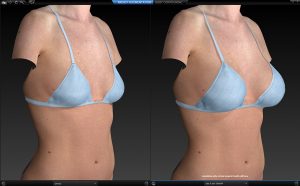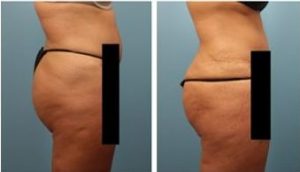Fat grafting (aka fat transfer) is a procedure that involves harvesting fat cells from one part of the body and transferring them to another area to add volume or to promote healing. This procedure first became popular in the mid-90s as a welcomed solution for breast and facial enhancement. However, even with expert techniques, the results of this procedure were not predictable. As a result, plastic surgeons developed a love-hate relationship with fat grafting.
With modern advancements, the predictability of fat grafting has improved, with approximately 50-70% of fat cells surviving the initial transfer. The transferred living tissues act as a permanent “filler” however, in highly mobile areas of the body, such as the lips, the results may not last long term.
With a growing number of inquiries about fat grafting for breast augmentation, buttock augmentation, and face enhancement from my Vancouver patients, I wanted to share my opinion on fat grafting.
Facial Augmentation

Fat transfer to lower face and cheeks at time of facelift.
As we age, the soft tissues and fat in our face begin to thin, which contributes to a more ‘aged’ appearance. Augmentation with temporary injectable fillers or fat grafting surgery can reverse some of these changes. Cheek and chin augmentation are the most common areas for this treatment. Due to the delicate and artistic nature of fat grafting to the face, this procedure must be done in the operating room under IV sedation or general anesthesia. Fat grafting of the face is most commonly done as an adjunct to facelift surgery to enhance the patient’s results.
As we discuss in a related blog post, safer and longer-lasting hyaluronic acid fillers are now available which give plastic surgeons a more predictable and immediate solution for facial volume loss and facial shape enhancement. In expert hands, these temporary fillers remain the preferred solution for facial rejuvenation when surgery is not needed or desired.
Breast Augmentation
In my opinion, fat transfer to the breasts is best suited as a synergistic procedure for other breast surgeries. Due to the characteristics of breast tissue, the amount of fat that can be safely transferred in one surgery is limited and as result, multiple surgeries may be required to achieve substantial augmentation with fat alone. Large volume breast augmentation with fat transfer alone cannot be consistently achieved and has significant risks. You can learn more about those risks from the American Society of Plastic Surgeons.
Which is better: implants or fat transfer?

Vectra Breast simulation program
If you are lean, looking to substantially change your breast shape, lift your breasts, or increase your breasts by more than 1 cup size, fat transfer alone is likely not an option for you. Breast augmentation using cohesive silicone gel or structured saline-filled implants is a much more popular, predictable, and versatile option for breast enhancement.
At YES we are able to simulate your new breast shape using our Vectra 3D imaging system. This remarkable technology greatly improves your understanding of your anatomy and what we can achieve with surgery.
Buttock Augmentation
The socially termed “Brazilian butt lift (BBL)” uses fat grafting to augment the shape and proportion of the buttocks. Typically, this procedure involves removing fat from the lower back and adjacent areas to enhance the curve of the waistline and transferring this harvested fat to the buttocks to increase volume.
In recent years, excessive buttock augmentation and exaggerated contours have been popularized by the media. Although dramatic, it’s important to remember that over time gravity will cause your heavier buttocks to fall, stretch your skin, and distort your proportions. When this occurs, you will need more surgery to correct your proportions. In some cases, fixing the damage is not possible.
Does fat transfer to the buttocks work?

Fat transfer to buttocks – Liposuction to abdomen, flanks and hips
Proportional enhancements will always have fewer complications and last longer. Weight fluctuations also affect the size of your fat cells and consequently the size of your buttocks. Reaching a stable weight before surgery and maintaining this after surgery will prolong the quality of your results.
What are the risks of fat transfer to buttocks?
If a large buttock is your goal, it is important to understand the associated risks. No surgery is risk-free, and in recent years, excessive buttocks augmentations have resulted in some serious complications, including a number of fatalities across North America. Analysis of these fatalities demonstrated that fat pulmonary embolism was the common cause. Third-party task forces have made procedure recommendations to reduce the risk of these complications. Sadly, these recommendations are not consistently followed by some surgeons.
Choosing an experienced and reputable Royal College-certified plastic surgeon to perform your surgery and opting for a smaller and more proportional buttocks enhancement will improve the safety of your procedure. At YES, we only recommended augmentations that will safely and proportionally enhance your figure. We also use the most scientifically validated techniques to harvest and graft your fat back into the body. These techniques improve not only the graft’s survival but also reduce risks.
Body Contouring With Fat Grafting
Previous trauma or surgery can sometimes result in dents or divots in the torso or extremity soft tissues. This can sometimes be corrected using fat grafting. A recent increase in dents and divots caused by noninvasive fat reduction devices that freeze fat has led to an increase in fat grafting requests to correct these post-treatment complications as well.
How Do Fat Grafting Costs Compare to Other Procedures?
It is a common misconception that fat grafting is less expensive than other cosmetic procedures or treatments. Fat transfer is a surgical procedure and must be performed in a fully accredited operating room. Due to the complexity and artistic nature of this procedure, the required surgery time is longer and therefore has associated operating room fees higher than that of other similar procedures.
Surgeon fees alone for facial fat grafting start at $3,500. Buttock enhancement starts at $7,500 and can reach upwards of $12,000 depending on the individual circumstances. If additional surgery is required to achieve your desired results, you should expect to pay for all aspects of this additional surgery.
My Recommendations for Patients
Fat transfer is a versatile tool for plastic surgeons, but there are limitations and risks just like every other procedure. Your best results start with a consultation with an experienced plastic surgeon who frequently performs these procedures. After considering your goals and preferences and assessing your tissues, you and your surgeon can evaluate your recommended options and select the best solution for you.
Fat grafting was something that I gained considerable experience with during my fellowship in 1995. Since that time, we have refined and built upon the techniques of fat grafting for all parts of the body. The plastic surgeons at YES are constantly evaluating the newest surgical techniques, aesthetic implants, and soft tissue fillers available to allow us to offer the best solutions for our patients.
To determine which procedure is right for you, call YES Cosmetic Surgery at (604) 888-9378 to speak with one of our experienced coordinators or use our online form to request a consultation with one of our plastic surgeons certified by the Royal College of Canada.

Leave a Reply